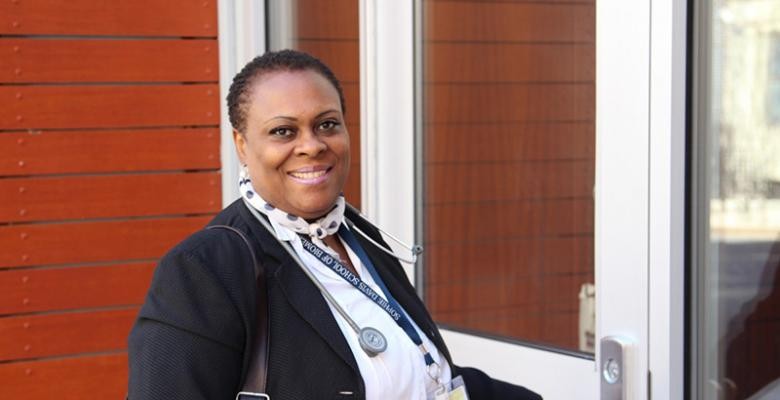Columbia Nursing Brings Primary Care Back to Patients’ Homes

Nurse practitioner Marie Carmel Garcon has worked at Columbia University Medical Center for 28 years, primarily in an infectious diseases intensive care unit and with dialysis patients. As she checked in with patients after they were discharged, though, she noticed that something was missing.
“A lot of the patients I talked to who had been released from the hospital could not leave their homes and needed help with follow-up care,” she said. “I didn’t feel as though my mission was fulfilled.”
Columbia Nursing’s faculty practice, ColumbiaDoctors Primary Care Nurse Practitioner Group, has now filled this gap between hospital and community with a new house calls practice staffed by board-certified nurse practitioners. Launched on May 15, it brings primary care services to the homes of those who need them most.
Garcon joined the group this spring. “I want to give patients the best possible quality care in their home,” she said. “It enables them to stay safe, happy and healthy, and that’s important to me.”
The Nurse Practitioner Group also offers LGBT, women’s health and mental health services in its Washington Heights office. “We saw an underserved need for access to quality health care in this community,” said Bobbie Berkowitz, dean of the Columbia School of Nursing. “Our new house calls service is an extension and reinforcement of our commitment to deliver quality primary care to our patients.”
The goal of the house calls practice is to provide clear and actionable treatment plans for patients—including chronic-disease management and follow-up care after hospitalization. “It is essentially the care that is provided in a healthcare provider’s office,” said Stephen Ferrara, associate dean of clinical affairs at the nursing school, who oversees the practice. “It could very well be adjusting medication for a patient’s high blood pressure, ordering lab services to evaluate the effectiveness of a treatment, or managing chronic illnesses through the coordination of other specialists.”
Until the 1940s, most primary care in the U.S. and the U.K. took place in the home; even as late as the 1960s, 40 percent of doctor-patient meetings were in the home. As the medical profession increased specialized in-patient care and began to depend more heavily on technology, in-home meetings dropped to less than one percent by 1980.
In-home visits began rising after 1998, when Medicare increased reimbursement for house calls by nearly 50 percent. Most house calls are by nurse practitioners.
Ferrara said house calls were not readily available in Washington Heights until now. “In such a densely populated neighborhood, there is no reason why we can’t take what we do in the office setting at our primary care office on 168th Street into the homes of patients who need it,” he said.
The Nurse Practitioner Group has offices in Morningside Heights and Midtown as well as Washington Heights, but for now the house-call service is available only to patients in Upper Manhattan who are unable to leave their homes due to health issues. “We know ultimately that people who do not have access to health care due to their home-bound status tend to be sicker, and there are things we can do to help prevent complications or hospital readmissions,” Ferrara said.
Most patients are expected to come through medical referrals. “We partner with medical institutions, with rehabilitation facilities and with short-stay nursing homes,” Ferrara said. “We want to work with discharge planners and help patients transition from those facilities to their homes.”
Garcon, the nurse practitioner, said she is eager to show her patients how much she cares. “Sometimes homebound patients are lonely, sometimes they feel isolated,” she said. “If they can’t work and are stuck at home, they may feel like society is no longer interested in them. I want them to know that I am interested, and there is somebody to care for them.”